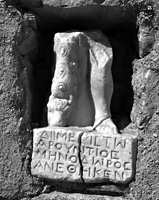 MAMA XI 313 (Perta)
MAMA XI 313 (Perta) 
Votive statuette dedicated by Arruntius Menodoros to Zeus Megistos
- Type of monument:
- Votive statuette.
- Location:
- Mernek (Karakaya) (Perta): in a house-wall.
- Description:
- Lower part of a white marble statuette on a shallow base. At left, knotted club resting on bucranium; at right, lower part of right leg.
- Dimensions:
- Ht. 0.33+ (base 0.10); W. 0.25; Th. --; letters 0.015-0.020.
- Record:
- MB notebook copy; photograph (1956/142).
- Publication:
- None.
- Date:
- Roman imperial period.
Διὶ Μεγ̣ίστῳ
Ἀρούντιος
Μηνόδωρος
ἀνέθηκεν.
Arruntius Menodoros dedicated (this) to Zeus Megistos.




The club makes it clear that the statuette dedicated by Menodoros to Zeus Megistos in fact depicted Herakles. Cf. the inscription on the base of an unpublished statuette of Herakles in the Afyon archaeological museum (from Çavdarlı): Ἀρτᾶς Ἀλεξάνδρου... τὸν Ἡρακλέα σὺν τῷ βωμῷ Ἀπόλλωνι ἀνέθηκεν καὶ καθιέρωσε.
The best attested family of Arruntii in this region is that of C. Arruntius Valens at Ikonion. Valens, whose floruit should be dated to the mid-second century AD, is attested in two Latin inscriptions in honour of his wife Claudia Eupatra Herois (Wiegand 1905: 324-5, no.1, with CIL III 14399b). Later Greek inscriptions from Ikonion provide the name of his son, L. Arruntius Longus (Cronin 1902: 122, no. 51; IGR III 1478), and his daughter, Arruntia Valentilla, who married into a family of Sertorii from Laodikeia on the Lykos (I.Konya 75, with Robert 1969: 360). The second-century equestrian officer M. Arruntius M.f. Serg. Frugi of Ikonion (ILS 9013; Pflaum 1960-1: I 373-5, no. 157) was presumably also a close relative of this family. Likely descendents of the family include Fl. Arruntius Rhetorius and Arruntius Olympios at Ikonion (I.Konya 201); Arruntius Diomedes, also at Ikonion (I.Konya 94); Arruntius Philostorgos at İsmil, in the far south-east of the territory of Ikonion (Laminger-Pascher 1984: 87, no. 147, with Drew-Bear 1987: 606 n.8, 607 n.4; cf. the commentary to MAMA XI 299 [1957/48]). On Arruntii in Asia Minor, see also the commentary to MAMA XI 32 (1956/46: Eumeneia).
The cult of Zeus Megistos is attested at Ikonion in Sterrett 1888a: 209, no. 227 (Konya: SEG 6, 412); Sterrett 1888a: 210, no. 228 (Konya: IGR III 261); I.Konya 18 (Sizma: in lines 1-2, read Αππα[ς Μ]|είρου). It is possible that the Zeus depicted on the early imperial coinage of Ikonion should be identified with Zeus Megistos (Aulock 1976: 75-7, nos. 190-8, 204-44). A cult of Zeus Megistos is also known at Lageina (modern Ilgın: Thonemann 2008: 43 n.3): see MAMA VII 1 (Meydanlı), 107 (Ilgın), 130 (near Mahmuthisar), 135 (Eldeş); I.Sultan Dağı 377 (Çavuşçu); Drew-Bear and Naour 1990: 1970-3. A native of Lageina set up a dedication to Zeus Megistos at Pillitokome (İnsuyu), west of Lake Tatta (Anderson 1899: 129, no. 148); other dedications to the deity are known from the region of Pillitokome (Anderson 1899: 132-3, nos. 160-1; MAMA I 373; MAMA VII 432, 521). A civic cult of Zeus is attested at Perta in MAMA XI 309 (1956/169) (cf. Zeus Akouseos in 312 [1956/182]), but it is not certain (pace Mitchell 1993: II 23 n.93) that this was a cult of Zeus Megistos. For a dedication to Zeus Stratios Megistos from the territory of Perta, see MAMA XI 311 (1956/186: Harman Çukuru).
Given that both the gentilician Arruntius and the cult of Zeus Megistos have strong associations with Ikonion, it is tempting to wonder whether this dedication has been carried across the Boz Dağ from the plain of Konya, and ought hence to be associated with Ikonion rather than Perta.
For a cult of Zeus Megistos at Canımana in south-western Galatia, north-west of Lake Tatta, see MAMA XI 248 (1957/15); 249 (1957/33).